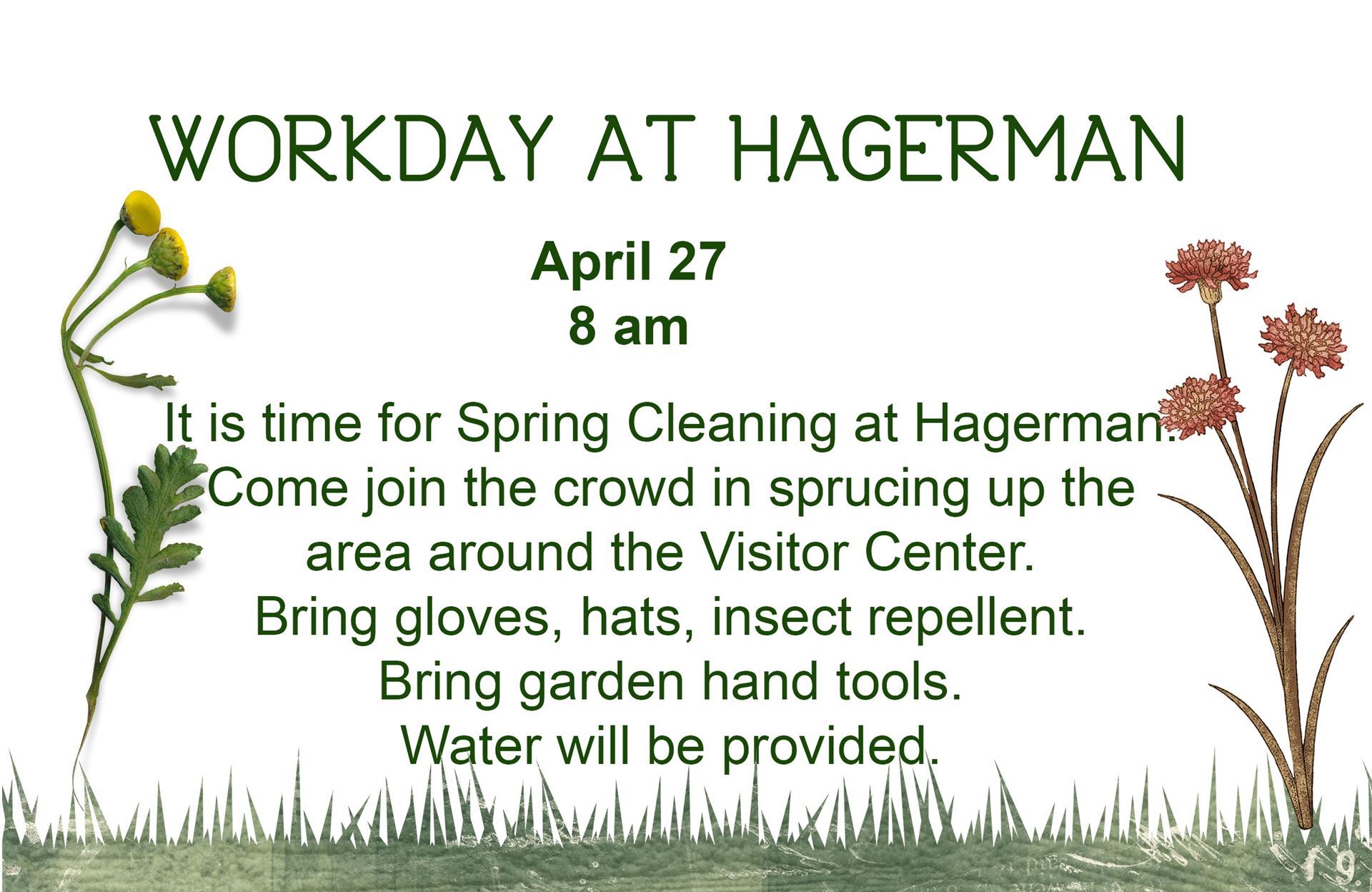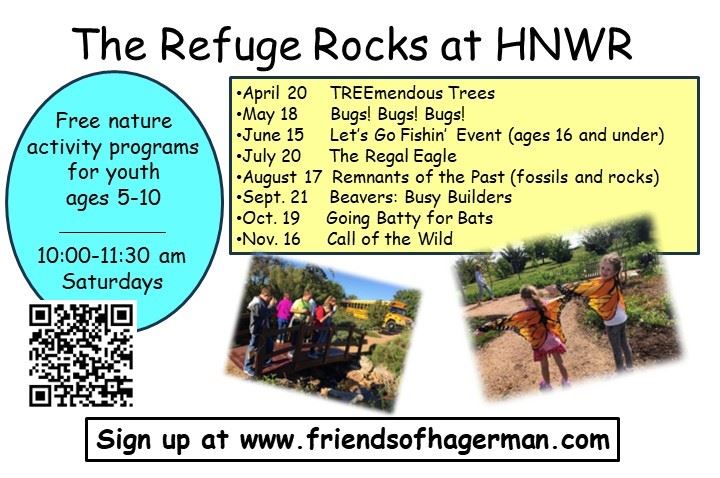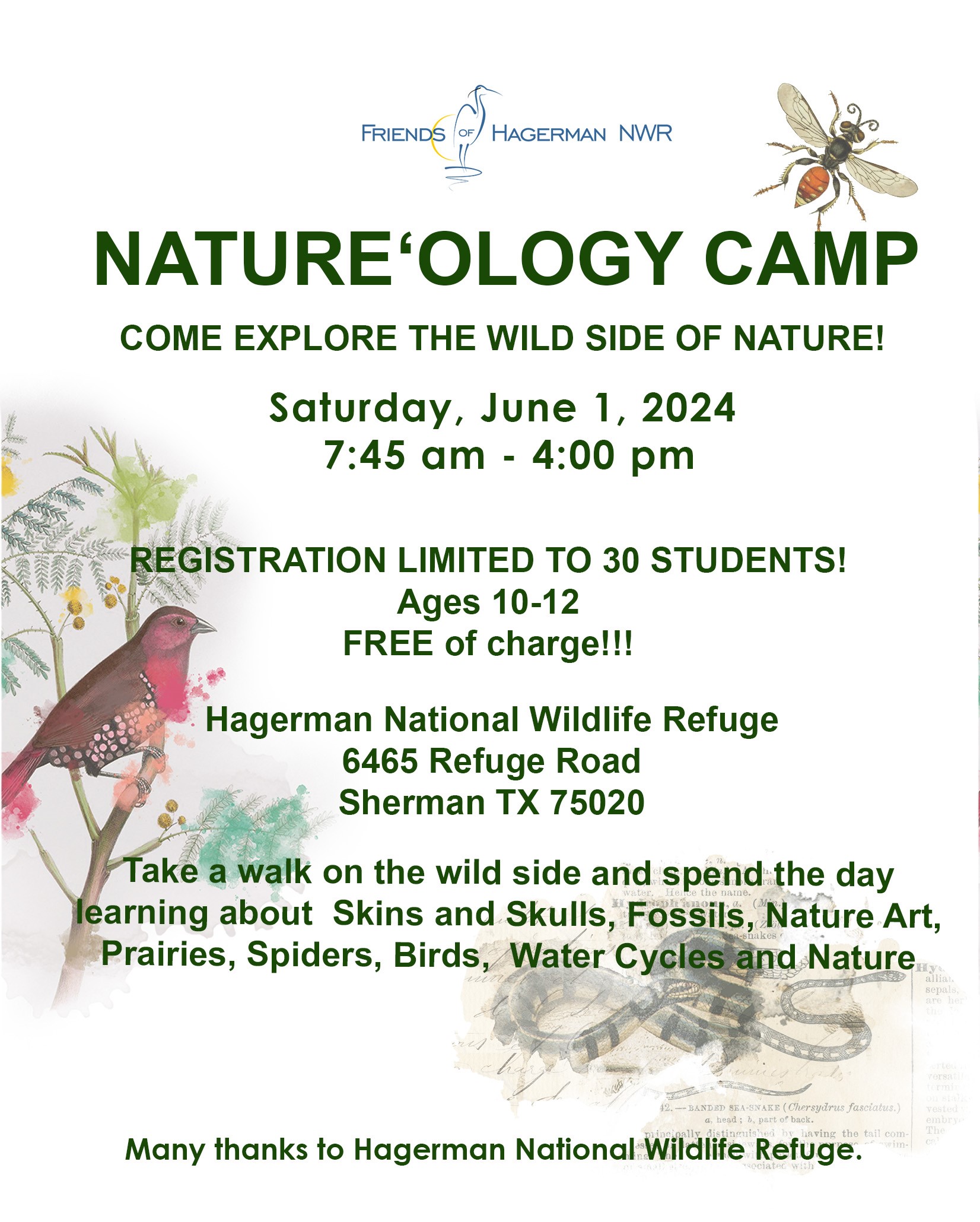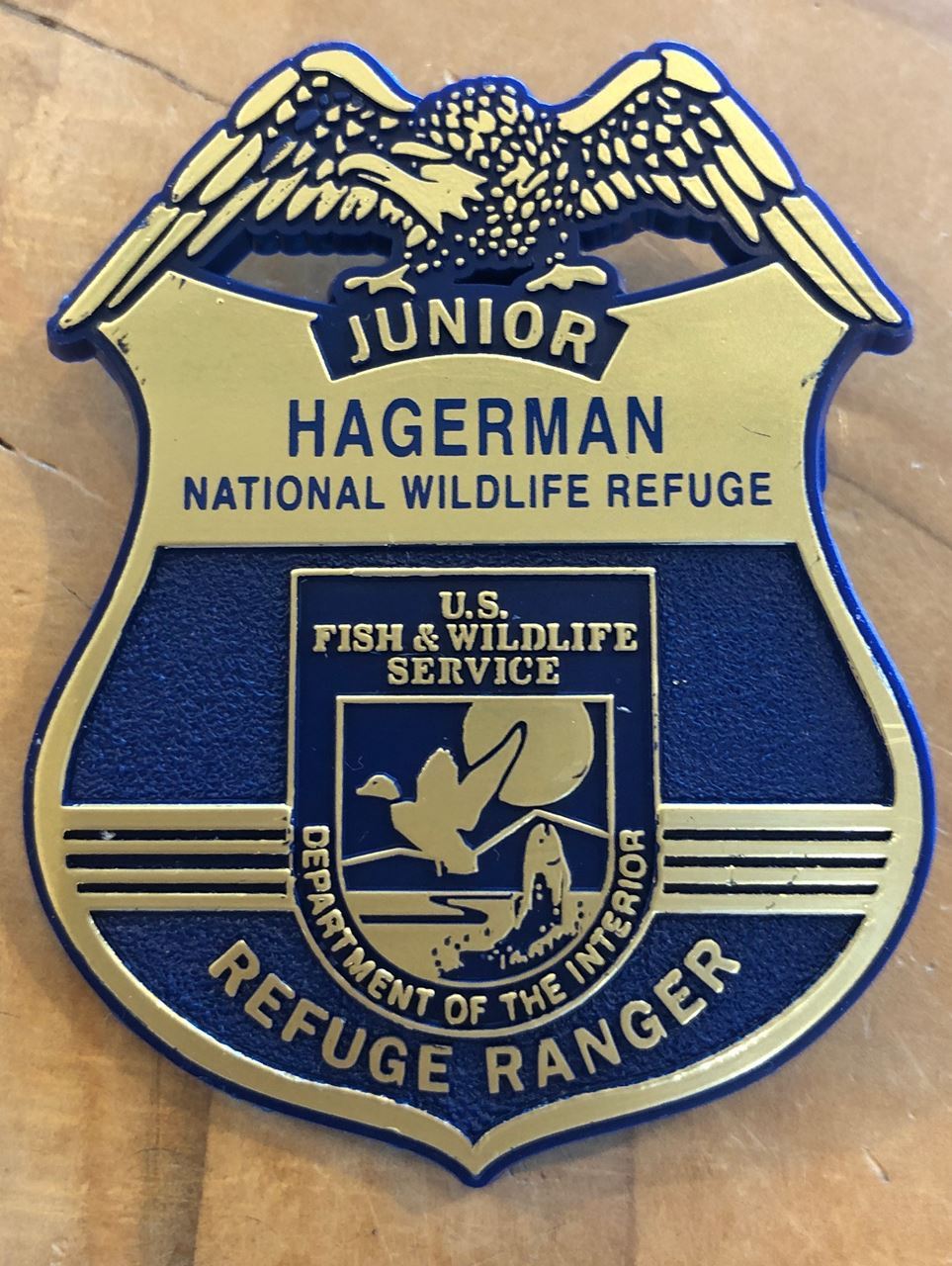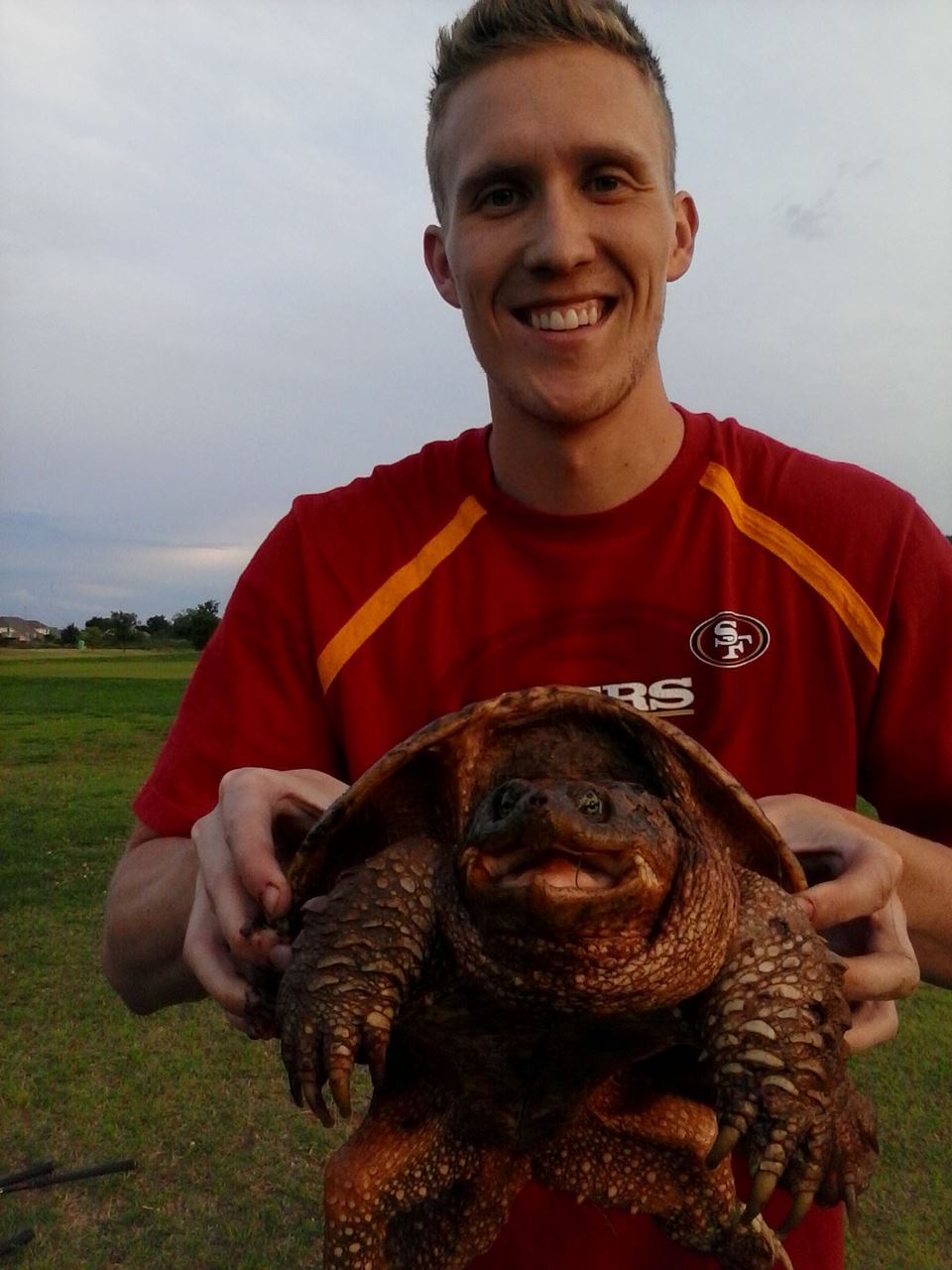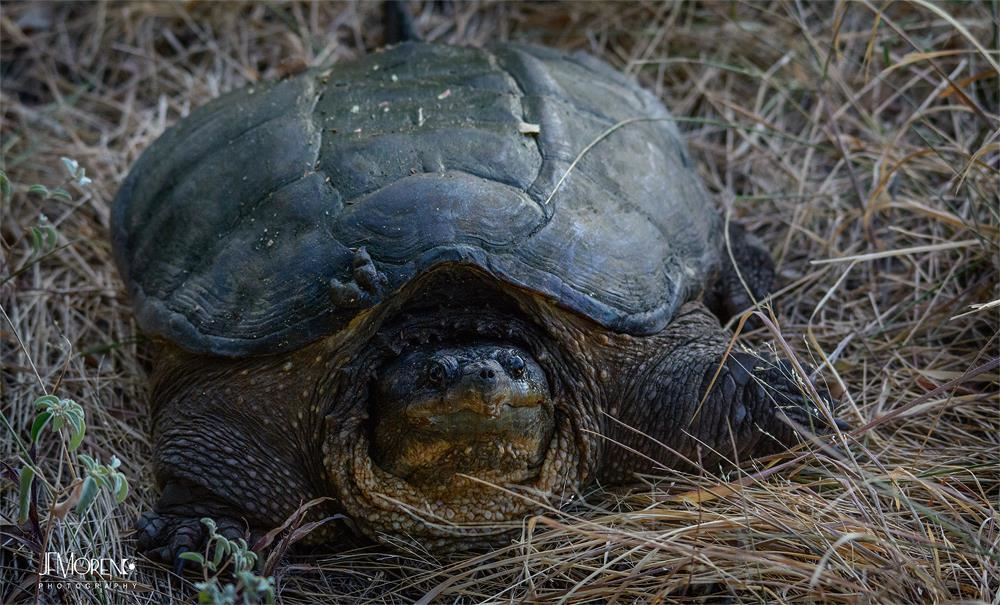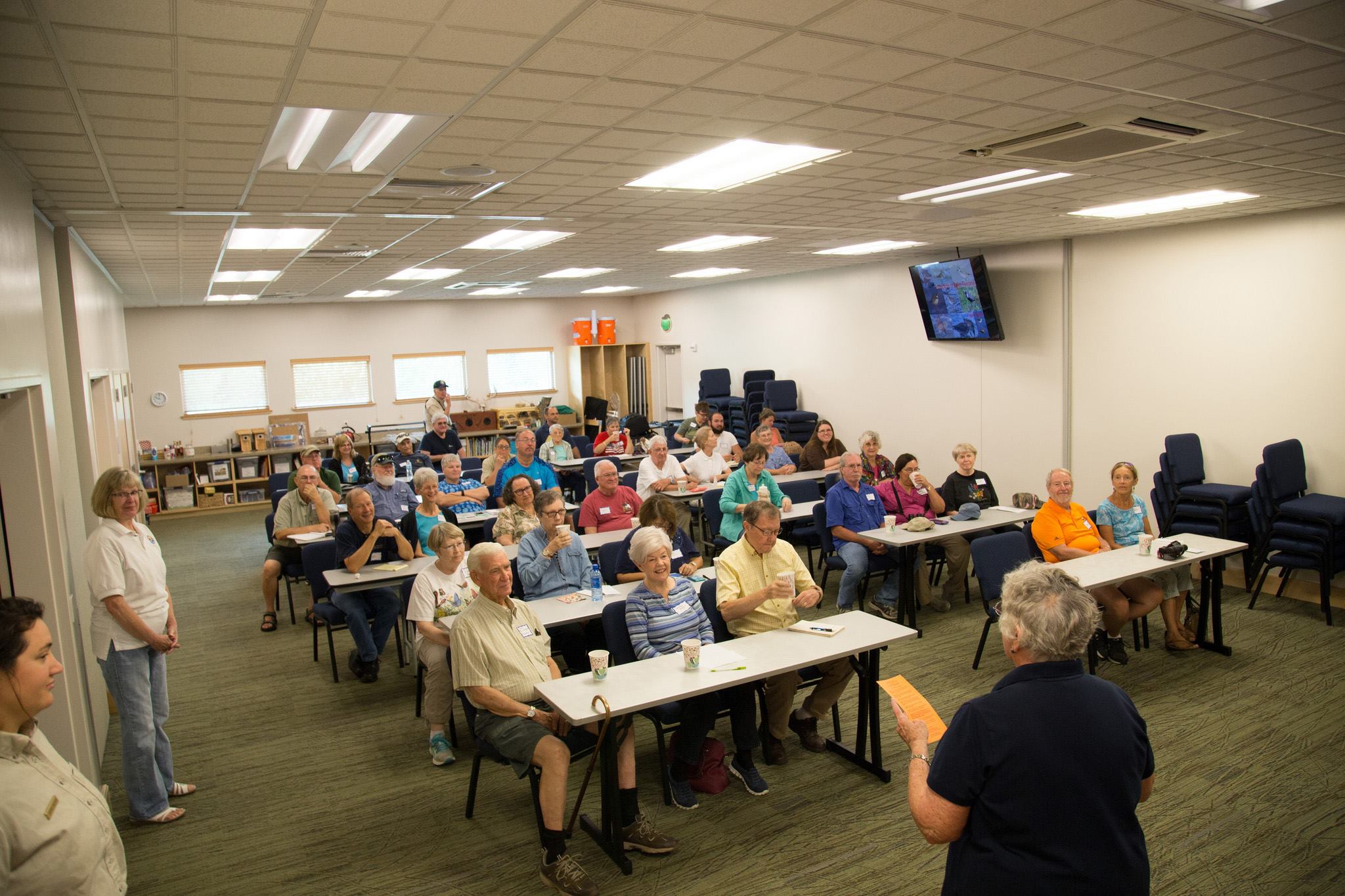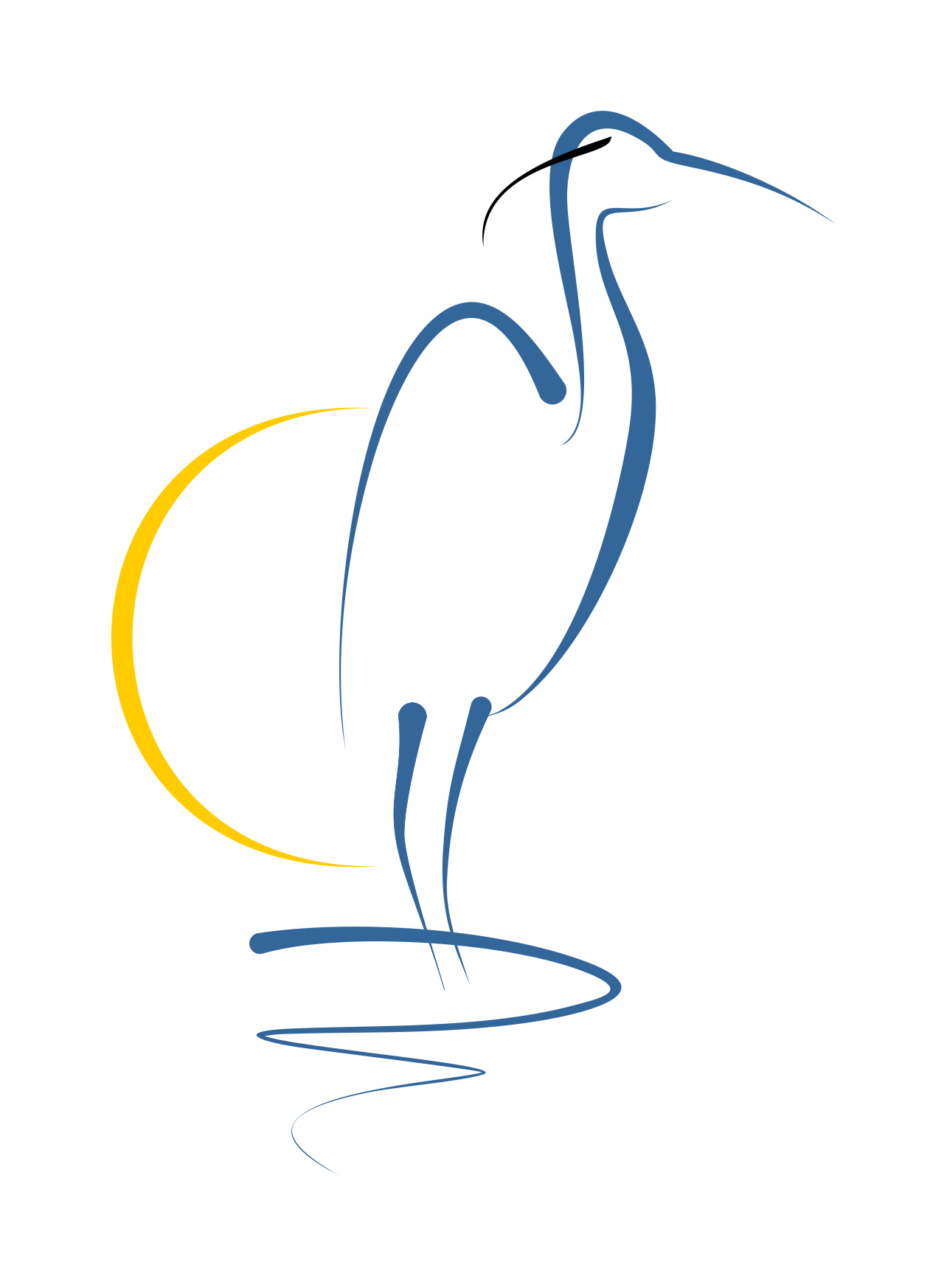Painted, Indigo and Lazuli Buntings
By Linda Micco Richmond
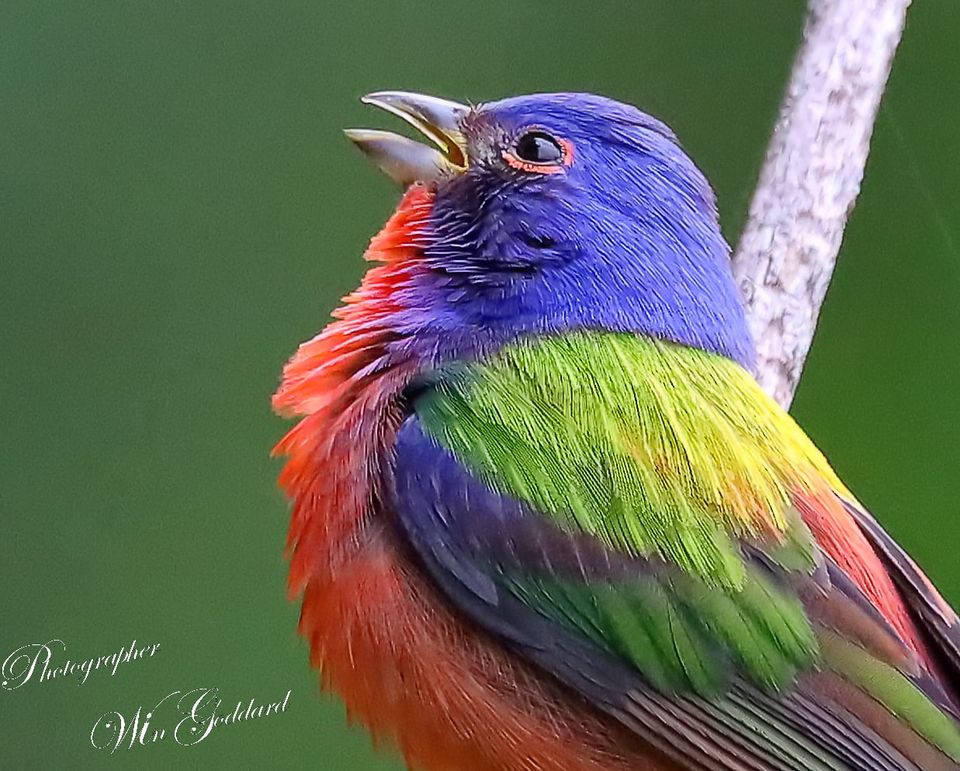
During breeding season, which typically starts in late April, a small but feisty male Painted Bunting stakes out a treetop to sing for a mate. He vigorously defends his territory from other males. Photo by Win Goddard
The most rainbow-colored bird in North America, the Painted Bunting, will soon arrive in North Texas for their summer stay, so it’s time to get ready. Members of the cardinal family, Painted Buntings are stocky, finch-sized birds with stubby beaks and feisty personalities. Their splashy primary colors though are what make birders long to catch a glimpse: males have a vivid blue head with a red eye ring, bright green back, and red rump and underbelly. Their tail feathers are multicolored. Even the females and immature males are a sight to behold; they sport dramatic lime green solid-colored plumage and a cream-colored eye ring. The French call the Painted Punting nonpareil, meaning “unrivalled.” The male Painted Bunting song is just as magnificent as its plumage. Their close cousins, Indigo Buntings, are named for the males' iridescent blue plumage. Their mates are a less showy brown with subtle blue tail feathers. Indigo Bunting by Pam Rendall-Bass | Events, Info & Activities Birding with Jack: Weekly Bird Census Tram Tours on the Wildlife Explorer! The Little Sit: April 6th at Sunrise Second Saturday: Paddlefish & Turtles Gardening, Mowing and Work Crew Visitor Center Volunteers Needed! Sponsor the Friends With a Membership Subscribe to Our Monthly Featherless Flyer |
Though both the Indigo and the Painted Buntings are abundant in Texas in the spring and summer, their small size, finicky nature, and tendency to perch alone in the treetops or in the cover of foliage may make them tricky to spot or even lure to your yard. Let’s explore the amazing world of buntings and ways to increase your chances of viewing these beauties at home or at Hagerman NWR. We chatted with bunting enthusiast and master naturalist Patricia A. Price -- who has hosted a flock of wild buntings in her rural backyard for the past decade -- for her best tips. “I’m not an expert, but I can tell you about my own experience,” Price told Featherless Flyer. Every year she clears her calendar in mid-April | Lazuli Bunting by Aaron Hamilton |
Typically, these Painted Buntings migrate in the spring from their winter home in Southern Mexico and Central America. They travel with their close kin, Indigo and Lazuli Buntings. The male Lazuli are brilliant sky blue with a blush of pumpkin on their chest and a white belly. After the briefest of pit stops – a few days or up to a week -- the Lazuli peel off from the flock to head for their true summer homes in states to the north and west of Texas. There the Lazuli breed and remain into fall.
How to Attract Painted Bunting
Price and her husband keep six feeders going for the Painted Buntings who remain all summer. Three trays contain only the preferred treat of the finicky buntings--white millet--and no other seed. In fact, the buntings eat their way through about 120 pounds of it on their property every summer, purchased in bulk at a feed store. “One year we accidentally bought red millet. The buntings wouldn’t touch it,” she said.
To make sure their offering is fresh enough for these exacting birds, every evening the Price family dump the previous day’s millet onto the ground for foraging buntings. Then they care for the feeders by following instructions from Cornell Labs: washing the trays in soapy water, rinsing with a solution of 1 part bleach and 9 parts water and carefully drying the feeders before refilling with fresh white millet.
Juvenile Painted Buntings Enjoying White Millet at the Hagerman NWR Visitor Center Photo by Nelda Zamir | Ten feet away from each white millet tray, the Price family keeps a feeder stocked with black oil sunflower seed. Buntings don’t touch them, she explained, but the sunflower seeds are a crucial part of the setup because they keep the larger, more assertive birds busy, such as Northern cardinals. Buntings don’t like to share and refuse to compete with other birds for food, she observed, so they require their own dedicated feeder. One challenge they have encountered is deterring the even larger-sized birds, such European Starlings, Red-winged Blackbirds, crows, doves, and cowbirds, some of which travel in enormous flocks and can drive off the buntings, she said. White millet and farm-raised mealworms are |
a supplemental treat food and not part of these birds’ wild diets. Like most birds in North America, buntings eat mostly insects in the early spring and summer to obtain the protein they need to reproduce. The females forage for insects to feed their hatchlings, which cannot digest seeds.
A manicured lawn or pesticide-treated yard doesn’t provide the food or habitat that buntings and other birds need. Planting vegetation in your yard that is native to your area is the best way to support the insect population that buntings and other songbirds require to thrive and reproduce.
Visit the Butterfly Garden at Hagerman Wildlife Refuge and view the Friends of Hagerman’s Native Plant List for Grayson County (or see https://www.npsot.org) to learn about growing Texas native plants. Note that buntings are more likely to visit a yard that has low, dense vegetation, or a mixture of scattered tall trees and low shrubs. Here are some other facts about Painted Buntings:
| Painted Bunting by Mike Petrick |
- Young buntings usually leave the nest just 9-12 days after hatching, according to the Audubon Society. Although female buntings tend the eggs and feed the hatchlings, males sometimes take over the feeding of fledglings while females begin a second nesting attempt. Males sometimes take a second mate in a season.
- According to the Cornell Lab of Orinthology, Indigo Buntings might also enjoy feeders with store-bought mealworms, which are the larval form of the mealworm beetle. The small thin imported black seeds known as Nyjer (sometimes misleadingly labeled as “thistle”) are another potential feeder food for buntings.
- The oldest recorded wild Painted Bunting was at least 12 years old, as reported from a Florida banding study.
- Buntings like to use standing dead trees, known as “snags,” as perches to forage for food, attract mates, and proclaim their nesting territory. If a tree on your property is dead or dying, consider cutting off only the canopy or top half and leaving the trunk standing, to serve as a song post for buntings and other songbirds.
- Bunting nests are sometimes parasitized by female cowbirds, who steal one of the bunting eggs and lay one of their own while the female bunting is away from the nest. Another risk for buntings: Poachers in Mexico often illegally capture Painted Buntings to sell as pets kept in cages. Yet these wild birds don’t make good pets and are best enjoyed in the wild where they belong.
Even if the buntings elude you, you are bound to have a good day at Hagerman National Wildlife Refuge!
Refuge Update: Though refuge lands are open from sunrise until sunset every day of the year, the Visitor Center is open Monday through Saturday 9-4, Sunday 1-5. It's a great time to visit the refuge! The annual limited quota wild turkey hunt will occur on April 22 – 24. Access to Godwin, Goode, Meyers Branch, SE Harris Creek, Big Mineral, and Sandy units will be restricted to permitted hunters only. The Auto Tour Route, Wildlife Drive, Bennett Lane, and Refuge Road will remain open to the public. Visitors will also be able to access the Visitor Center, Harris Creek and Crow Hill trails, both boat ramps, and the Big Mineral Day Use Area. Hunt Map |
No pictures to show
Photos by Donnie Simmons
Upcoming Activities:
The Friends of Hagerman is Hosting 17 Family Friendly Events in April! |
|
Native Plant Gardening Resources for Grayson County
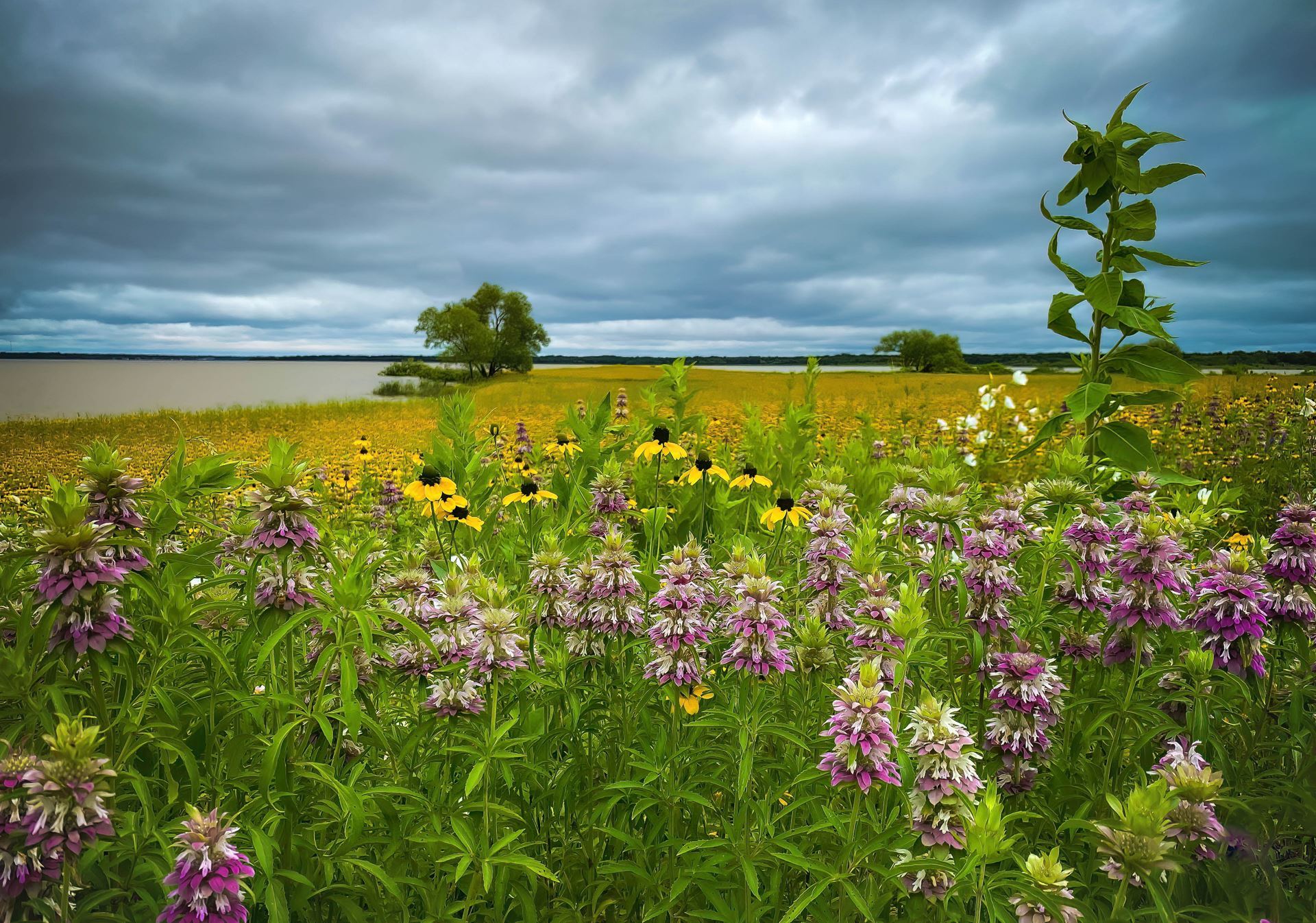
Our website offers a treasure trove of information about native plants and attracting hummingbirds, butterflies and other pollinators. Checkout our Butterfly Garden and Butterflies under the Wildlife Menu!
NEW! Updated Host and Nectar Plants for Garden Butterflies
Native Plant List for Grayson County: An extensive list of plants known to host various butterflies. Many are in our Butterfly Garden.
How to Build a Butterfly Garden
Join the Butterfly Garden Docents Training Meeting April 6th Do you love butterflies and native plants, like to learn new things, enjoy being outdoors and meeting new people, and like helping others learn? Then consider joining the Hagerman Butterfly Garden Docent Program! |
.jpg)
The eclipse at the refuge will be 99.62% of totality.
Check your eclipse percentage with the NSO Eclipse Map
Please feel free to join our waiting list: we may have cancellations. Questions? Email: friendsofhagerman@gmail.com |
| Puddles' Craft Corner Earth Day 2024 By Cindy Steele, Master Naturalist |
It’s that time of year to celebrate our home – the Earth! We live on this great big, wonderful planet, so it’s time to celebrate our home and think about ways to keep the Earth healthy and happy! Earth Day is celebrated each year in April. This year’s Earth Day celebration will be on Monday, April 22, 2024. Our planet is a wonderful place to live, but it needs our help to thrive! That’s why each year on April 22, more than a billion people celebrate Earth Day to protect the planet from things like pollution and deforestation. By taking part in activities like picking up litter and planting trees, we’re making our world a happier, healthier place to live. Earth Day is a great time to think about all the ways the Earth takes care of us and think of ways that we can take care of it! From the soil that helps to grow the food we eat to the water and air that give us life, we have so much to thank Mother Earth for. Earth Day is a good opportunity to get back in touch with nature and give back in ways that make the Earth a better place for all of us to live. Celebrating Earth Day With Kids Getting kids involved in taking care of the planet when they’re young encourages them to continue these habits as they grow older. It’s important to teach kids to be good stewards of the Earth and encourages them to love and respect their planet and nature. There are so many fun and engaging ways you can celebrate Earth Day with kids and family while being conscious of taking care of it and making it a safe and wonderful place to live! Here are some great ideas to do with kids and the family! 1. Go On A Nature Scavenger Hunt It’s always fun to go on a nature hike and it’s even more fun to make the hike a scavenger hunt! Make a list of natural things that you want to hunt for while going on your hike. You can find lots of nature scavenger hunt ideas and forms online. There are also... |
|
Complete a scavenger hunt, a leaf rubbing and identify a few common birds to become a Junior Ranger. At the end of the journey report back to the Visitor Center where you will be guided through the Junior Ranger Pledge and receive a merit of completion. Print a Hagerman-specific Junior Ranger Packet or Advanced Jr. Ranger Packet or pick one up in the Visitor Center. |
| The Junior Ranger Pledge As a Junior Ranger at Hagerman National Wildlife Refuge, I pledge to protect outdoor creatures small, big and huge. To keep the water, air and land clean. To make enjoying nature a routine. I will share my new skills with family and friends. When people and nature work together, everybody wins! |
Left to Right: Mike Petrick, Nancy Riggs, Jack Chiles and Terry Goode Each Tuesday a team of experienced birders, including Master Naturalist Jack Chiles, traverse 35 miles of refuge roads and hiking trails, documenting every bird they encounter. This Bird Census is reported to The Cornell Lab of Ornithology for use in research, and each week we will bring you a link to their actual bird count, and a summary of their adventures.
|
|
To see more of Jack's birding adventures, visit Birding with Jack |
Photo Club Scavenger Hunt: April 20, 2024 The Friends of Hagerman NWR Nature Photography Club will have a Photo Scavenger Hunt. Photo club members, guests, and visitors are welcome to participate in the photo scavenger hunt. Photo Scavenger Hunt list will be available on April 20. What is a Photo Scavenger Hunt? Where do you get the list? - The list will be mailed to photo club members by 5:00 am on April 20, 2024. - The list will be available on April 20th on the FOH Website at Photo Scavenger Hunt list. Share your photos - Everyone is welcome to post your photos on Facebook in the Friends of Hagerman NWR Nature Photography Group. Photo Club Members’ photos slideshow - We will present a slideshow of photo club members' photos during an upcoming photo club meeting. - All photos must be taken on April 20, 2024. To be included in the slideshow, send your images no later than 6 pm on April 28, Sunday. Only one photo per category. Filename of each image should include your name and the category (for example, Lisa Wilkins - Purple.jpg). Email your images to FOHphotoclub@gmail.com OR use WeTransfer.com to send your images to FOHphotoclub@gmail.com. For questions about this event, contact: Pam Rendall-Bass, Event Leader Phone 817-773-1322 Email rendallnaturephotography@gmail.com _____________________________________________ For questions about the photo club, contact: Lisa Wilkins, Photo Club Leader Email FOHphotoclub@gmail.com Future Photo Club Events: |
Register for a Tram Tour Today! |
|
Group Tram Tour |
Sunrise at the Little Sit by Laurie Sheppard | Photo by Cathy Van Bebber |
Meet Jack and the Bird Census Team and learn how to identify the birds of North Texas while enjoying the beautiful sunrise over Lake Texoma! Modeled after Cornell's national "Big Sit" event, a group of dedicated birders invite you to join them at sunrise to conduct a bird count as multiple species fly to the water and the surrounding land to feed. Leaders will bring spotting scopes and will provide tips for identification of the many species you will see. This event lasts a couple of hours, but all are welcome to come and go as they please. Participants are advised to bring a chair, binoculars and water. The First Saturday of every month, beginning 30 minutes before sunrise. |
Location: H Pad, Sadler, Texas 76264 (H Pad is in Sadler, but it is part of the refuge) GPS Coordinates: 33.734961, -96.780582
|
|
Early Bird Walk with Jack Chiles |
No pictures to show |
Master Naturalist Jack Chiles will lead our Early Birding event, weather permitting. Bring binoculars or borrow ours. Meet at the Visitor Center and return in time for the Second Saturday program. |
Please Register (Optional) so we may inform you via email of unforseen changes/cancellations. |
Second Saturday: Snapping Turtles and American Paddlefish with Benhamin Thomas Saturday, April 13th at 10:00 AM in the Visitor Center
Spencer Beard, Hagerman NWR Visitor Services Manager holding a Snapping Turtle. Tishomingo National Fish Hatchery (TNFH) initiated their Alligator Snapping Turtle (Macrochelys Temminckii) head-start program in 2000 with the objective of augmenting naturally occurring populations with low densities and reintroducing the turtles to extirpated populations where they historically occurred. Come lean how, at TNFH, hatchlings are housed, juveniles learn to hunt in ponds, and who benefits from the turtles. TNFH also annually spawns adult American Paddlefish (Polyodon Spathula) to hatch and rear juvenile fish for stocking to reestablish a self-sustaining population. Benjamin Thomas started work as a Fish Biologist at Tishomingo National Fish Hatchery in March 2023. He has been with the US Fish and Wildlife Service since 2020 and has a BS in Biology from Wittenberg University in Springfield Ohio and a MS in Biology from the University of Central Missouri. Ben is the lead biologist overseeing the alligator snapping turtle head start program and assists with the spawning of paddlefish, alligator gar, channel catfish and rearing of the resulting fry.
Photo by Jesus Moreno, taken on the refuge in 2015, estimated to be two feet long. Future Second Saturday Programs |
|
|
Do You Like to Work Outside? The Refuge Needs You! |
It takes a lot of people to have a beautiful garden! The Wednesday Garden Team Love to work with native plants and meet other gardeners? Come and help us add plants, weed and mulch our beautiful butterfly garden. Garden Team volunteers get first dibs on thinned native plants as well as access to seeds and cuttings for propagation. Gardeners meet on most Wednesdays, but times vary. Contact Us to subscribe to the volunteer garden team weekly email. Provide own tools and gloves. Minimum age 18, or 16 if accompanied by parent/volunteer. |
Mowing and Refuge Beautification: The Work Crew Do you enjoy working outside, mowing, sprucing up hiking trails, trimming and removing brush and general cleanup? Show your love for nature by joining the Outdoor Crew at Hagerman National Wildlife Refuge. Outdoor Crew volunteers meet on the First Tuesday and Fourth Saturday of every month. Contact Us for exact times, dates and other details about joining the volunteer Work Crew. Scouts welcome! |
Visitor Center Volunteers Needed! |
Do you enjoy meeting all kinds of people from all over the world, and like-minded people in our area? If yes, consider joining our team of Visitor Center Volunteers. You will greet refuge guests, distribute maps and other refuge information, and make sales in the gift shop. Shifts available every day of the week: Monday through Saturday 9 AM to 12:30 PM and 12:30 to 4:00 PM, Sunday 1:00 to 5:00 PM. Training is provided. Contact Us if interested. |
Sponsor the Friends of Hagerman NWR with a Membership
Sponsors Enable the Friends to…
Join Today! Memberships available for $10 |
| Thank You To Our Contributors: Spencer Beard, Jack Chiles, Aaron Hamilton, Jesus Moreno, Mike Petrick, Pam Rendall-Bass, Linda Micco-Richmond, Cindy Steele, Lisa Wilkins, Nelda Zamir Refuge Manager: Kathy Whaley Deputy Refuge Manager: Paul Balkenbush Visitor Services Manager: Spencer Beard Friends of Hagerman NWR Foundation 6465 Refuge Road, Sherman, TX 75092 Phone: 903-786-2826 Join us on Facebook: |
Search for any word--do not use quotes for phrases |
Kroger: Stop by the customer service desk at Kroger and link your Kroger Card to the Friends of Hagerman: the Friends will get rewards for every dollar you spend, at no cost to you.
Please add info@friendsofhagerman.org to your contacts to ensure delivery of registration confirmations, account information and the Featherless Flyer
See you at the refuge!

